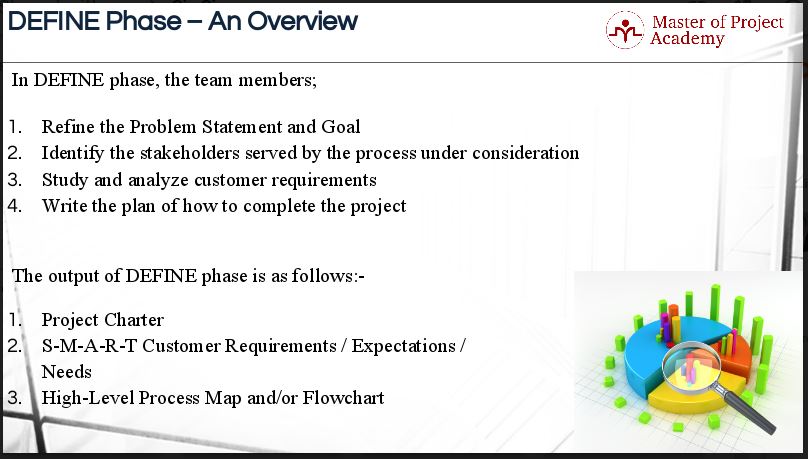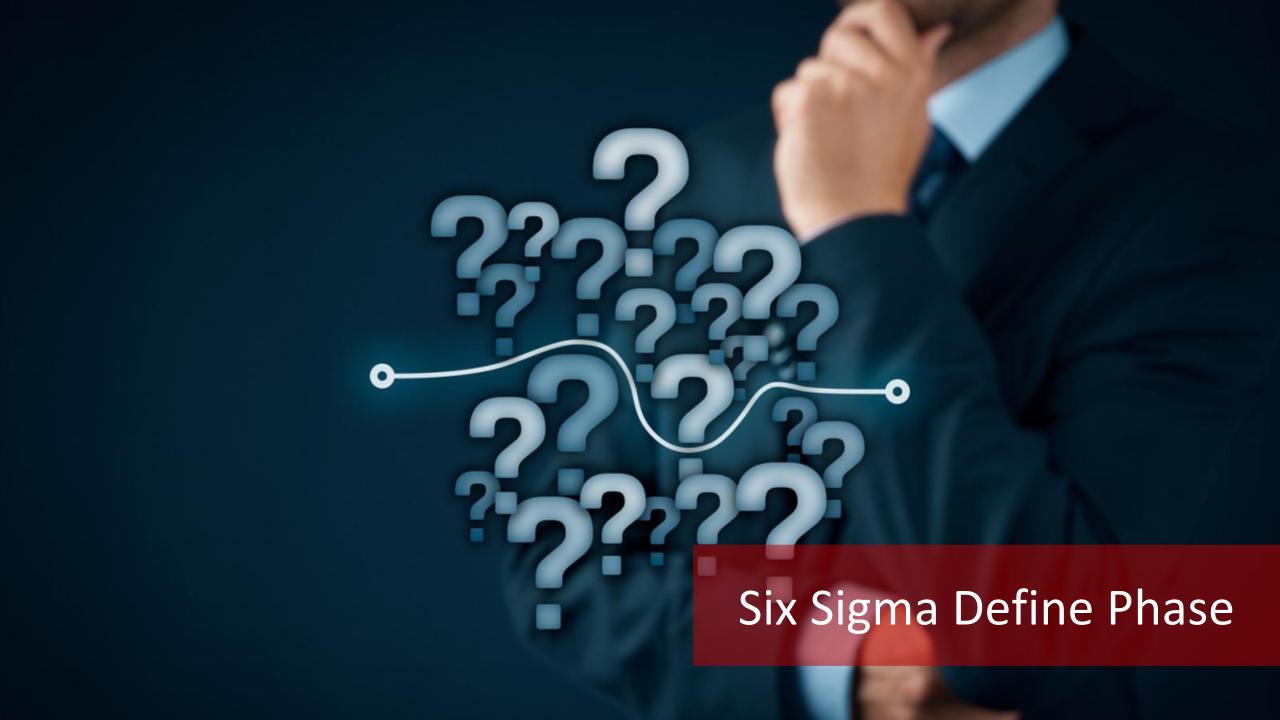A Six Sigma project is divided into five phases: Define, Measure Phase, Analyze, Improve, and Control. As you will learn in a Lean Six Sigma Green Belt course, these five stages are abbreviated as DMAIC. In order to certify as a Six Sigma Green Belt, you have to have a solid understanding of Six Sigma principles and the whole Six Sigma approach. To do that, you have to understand each phase in detail. As also explained in the online free Six Sigma training a Six Sigma project cannot start without going through the Six Sigma Define stage.
Attend our 100% Online & Self-Paced Free Six Sigma Training.
Overview
The first point that we need to talk about when discussing the Six Sigma Define phase is defining the Problem Statement and Goal by the project team members. The primary purpose of the Six Sigma Define phase is to ensure the project team is focusing on the feasible business problem or pain area.
Refining the problem statement means narrowing down the scope of the problem to increase focus. Refining the goal means changing the goal into numbers. The problem statement and goal have to be S-M- A-R- T. It is an acronym that stands for Specific, Measurable, Achievable, Realistic, and Time-bound.

The problem statement is also called an Opportunity Statement. Let us try to understand the background of the word ‘Opportunity’. An opportunity refers to process improvement or process excellence opportunity to exceed stakeholders’ expectations. The need for a Six Sigma project can arise from a business problem or an improvement opportunity. An improvement opportunity may not necessarily be a business problem.
The second point indicates that the project team needs to identify the stakeholders served by the process. In the Six Sigma Define phase, the Six Sigma project team identifies the internal and external stakeholders being served by the process under consideration. The team studies and analyzes customer requirements too. The data and information regarding customer needs and expectations are called the Voice of the Customer (VoC) data. There are different methods and techniques of VoC data collection such as qualitative and/or quantitative, subjective and/or objective methods.
The third point is about writing a plan to complete the project. Once the business problem is found feasible to be undertaken in the form of a Six Sigma project, the project team comes up with the project charter or agreement which normally consists of an end-to-end plan to complete the Six Sigma project.
5 Key Deliverables
Let us have a look at the 5 key deliverables in the Lean Six Sigma Define phase. These deliverables are nothing but the objectives of the Define phase. Let’s discuss these one by one:
The 1st Lean Six Sigma Define Phase Key Deliverable: Process Map
The first key deliverable of the Six Sigma Define phase is to understand what the project is all about. In order to understand the project, we need to have sufficient know-how about the process as well. Once we understand the process, we will have insight into the causes of inefficiency and frustration so that improvements can be made. A Process Flowchart Process map or Standard Operating Procedure (SOP) document should be able to help you drill down into the process
Check our Six Sigma Training Video
The 2nd Six Sigma Define Phase Key Deliverable: Project Scope
The second key deliverable of the Six Sigma Define phase is to determine the boundaries of the process area for improvement. In simple words, determining the process boundaries means understanding where the process begins and ends. The scoping study in a Six Sigma project normally consists of determining boundaries in terms of documenting a list of specific project goals, deliverables, tasks, costs, and timelines. In the Six Sigma Define phase, the project leaders are responsible for clarifying the purpose and scope of the project. They need to be well aware of the problem area and the kind of improvement that is required to be made.
The 3rd Six Sigma Define Phase Key Deliverable: Identify Stakeholders
The third deliverable of the Six Sigma Define Phase is to identify all the stakeholders (Internal and External) served by the process. A stakeholder is anyone impacted by the project. The impact could be positive or negative; of course. Every process will have internal and external stakeholders to whom it is catering to. Depending on the kind of organizational setup, the stakeholders and their expectations would certainly vary.
In the Six Sigma Define phase, the project manager needs to identify all key and non-key stakeholders required to support and sustain the project and its improvement. Internal key and non-key stakeholders are normally your colleagues, supervisors, managers, directors, etc. External key and non-key stakeholders are normally your vendors, customers, suppliers, creditors, etc.

The 4th Six Sigma Define Phase Key Deliverable: Define Stakeholder Requirements
The fourth deliverable of the Six Sigma Define phase is to define stakeholders’ requirements. To add to what we previously discussed regarding identifying internal and external stakeholders, the project leader or manager, during the Six Sigma Define phase itself, has to define internal and external stakeholders’ needs, requirements and expectations. Just to give you a quick brief, defining customer expectations will have two steps:
- Describe customer expectations.
- Find out how feasible or viable the expectation is for the Six Sigma project to fulfill.
The 5th Six Sigma Define Phase Key Deliverable: Create Project Plans
The fifth key deliverable of the Six Sigma Define phase is to create a plan to complete the Six Sigma project. A plan to complete the project is normally one of the components of the Project Agreement and can be as exhaustive as it needs to be complete and comprehensive. The project plan normally consists of Resource Plan, Stakeholder Management Plan, Communication Management Plan, Scope Management Plan, Cost/Benefit plan, etc.

Outputs
The first output of the Six Sigma Define phase is the Project Charter. By the end of the Six Sigma Define phase, the project team will be ready with a project charter or agreement; which is duly approved or signed off by the Six Sigma project champions or sponsors. The team will also have a list of feasible customer requirements or expectations that need to be fulfilled as a result of the implementation of the solutions by the Six Sigma projects. The documented flowchart or process map can also be published by the project team at the end of the Six Sigma Define phase. The process map or flowchart would belong to the process where the business problem occurs and recurs in due course.
This article gives an overview of the Six Sigma Define phase. There is much more information available on this topic such as how to create a burning platform and a business case, how to draw up a process map, the SIPOC principle, etc. The Six Sigma Define Phase is the foundation for the whole Six Sigma project. By following the steps of the Six Siga Define phase carefully and completely, you will have a solid foundation on which to build the rest of the Six Sigma stages.



3 thoughts on “The 5 Deliverables of Six Sigma Define Phase”
Comments are closed.